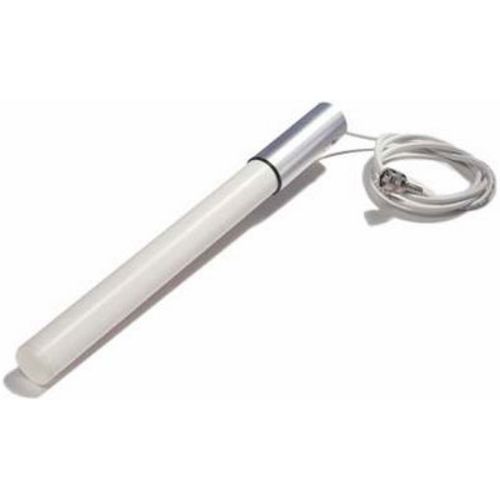
Cisco Aironet ANT2506
Designed for WLAN applications in the 2.4- to 2.5-GHz frequency range, the antenna has a nominal gain of 5.2 dBi and is typically mounted indoors or outdoors on a mast.
Designed for WLAN applications in the 2.4- to 2.5-GHz frequency range, the antenna has a nominal gain of 5.2 dBi and is typically mounted indoors or outdoors on a mast. The antenna is compatible with Cisco Aironet radio products utilizing a reverse polarity TNC (RP-TNC) connector.
|
Antenna type |
Dipole |
|
|
Operating frequency range |
2.4- to 2.84-GHz |
|
|
Environment |
Indoor/outdoor |
|
|
Nominal input impedance |
50 Ohms |
|
|
VSWR |
Less than 2:1, 1.5:1 nominal |
|
|
Gain |
5.2 dBi |
|
|
Polarization |
Linear, vertical |
|
|
E-Plane (3dB bandwidth) |
36 degrees |
|
|
H-Plane (3dB bandwidth) |
Omnidirectional |
|
|
Cable length and type |
3 ft. (0.91 m) |
|
|
Dimensions (H x W) |
11.5 in x 1.125 in. |
|
|
Mounting |
Mast, 2 in (5.08 cm) maximum |
|
|
Operating temperature range |
-30° to 70° C |
E-Plane Pattern
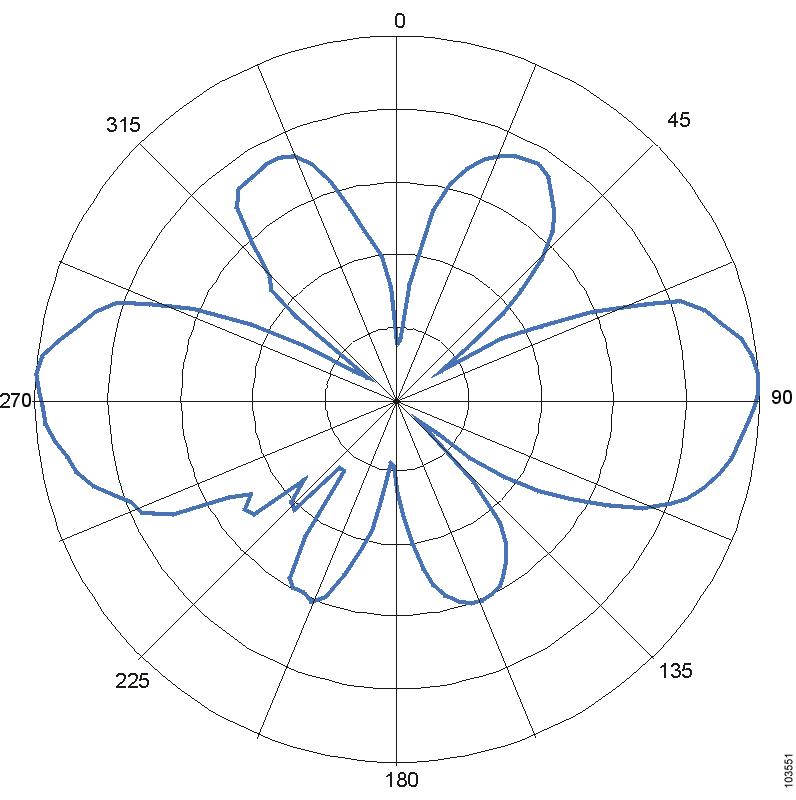
H-Plane Pattern
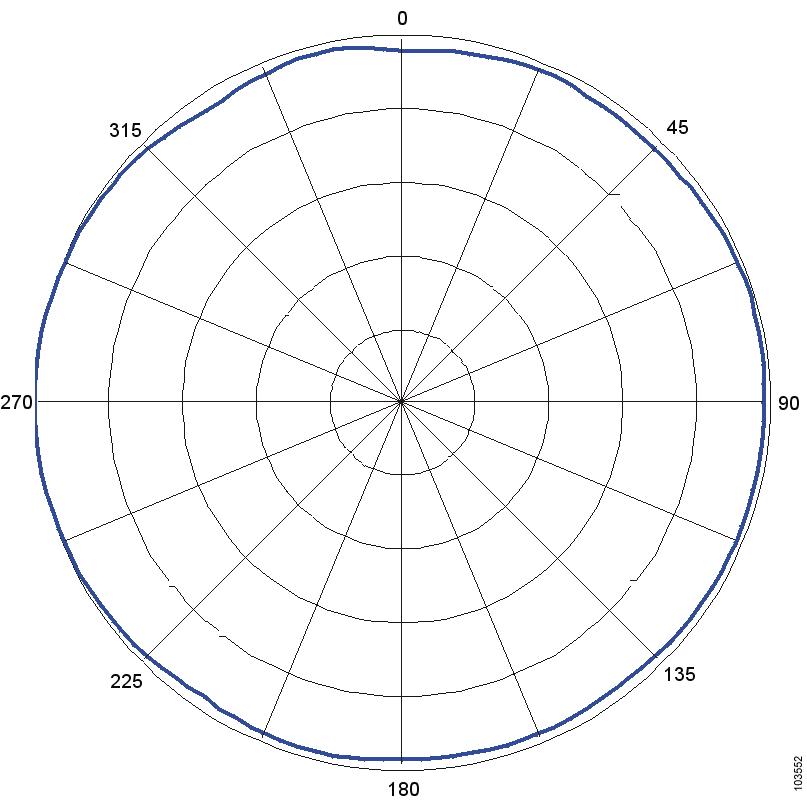
System Requirements
This antenna is compatible with any 2.4-GHz Cisco Aironet radio device with an RP-TNC connector.
Installation Notes
General Installation Instructions for Mast Mounted Antennas
The following instructions are common to most mast mounted installations.
1.  Assemble your new antenna on the ground at the installation site.
Assemble your new antenna on the ground at the installation site.
2.  Attach the antenna to the mast and connect its coaxial cable while you are on the ground.
Attach the antenna to the mast and connect its coaxial cable while you are on the ground.
3.  Make sure the mast doesn`t fall the "wrong way" should you lose control as you raise or take down the mast. Use a durable non-conductive rope secured at each two foot level as the mast is raised. Have an assistant tend the rope, ready to pull the mast clear of any hazards (such as power lines) should it begin to fall.
Make sure the mast doesn`t fall the "wrong way" should you lose control as you raise or take down the mast. Use a durable non-conductive rope secured at each two foot level as the mast is raised. Have an assistant tend the rope, ready to pull the mast clear of any hazards (such as power lines) should it begin to fall.
4.  Use the mounting bracket provided with the antenna.
Use the mounting bracket provided with the antenna.
5.  If the installation will use guy wires:
If the installation will use guy wires:
- Install guy anchor bolts.
- Estimate the length of guy wire and cut it before raising the mast.
- Attach guy wires to a mast using guy rings.
6.  Carefully connect the antenna and mast assembly to its mounting bracket and tighten the clamp bolts.
Carefully connect the antenna and mast assembly to its mounting bracket and tighten the clamp bolts.
- In the case of a a guyed installation, you must have at least one assistant to hold the mast upright while the guy wires are attached and tightened to the anchor bolts.
7.  Attach the provided self-adhering "DANGER" label at eye level on the mast.
Attach the provided self-adhering "DANGER" label at eye level on the mast.
8.  Install ground rods to remove any static electricity buildup and connect a ground wire to the mast and ground rod. Use ground rods designed for that purpose, not a spare piece of pipe.
Install ground rods to remove any static electricity buildup and connect a ground wire to the mast and ground rod. Use ground rods designed for that purpose, not a spare piece of pipe.
Grounding the Antenna
Follow these guidelines to ground the antenna in accordance with national electrical code instructions.
1.  Use No. 10 AWG copper or No. 8 or larger copper-clad steel or bronze wire as ground wires for both mast and lead-in. Securely clamp the wire to the bottom of the mast.
Use No. 10 AWG copper or No. 8 or larger copper-clad steel or bronze wire as ground wires for both mast and lead-in. Securely clamp the wire to the bottom of the mast.
2.  Secure the lead-in wire to a lightning arrestor and mast ground wire to the building with stand-off insulators spaced from 4 feet (1.2 meters) to 8 feet (1.8 meters) apart.
Secure the lead-in wire to a lightning arrestor and mast ground wire to the building with stand-off insulators spaced from 4 feet (1.2 meters) to 8 feet (1.8 meters) apart.
3.  Mount the lightning arrestor as close as possible to where the lead-in wire enters the building.
Mount the lightning arrestor as close as possible to where the lead-in wire enters the building.
4.  Drill a hole in the building`s wall as close as possible to the equipment to which you will connect the lead-in cable.
Drill a hole in the building`s wall as close as possible to the equipment to which you will connect the lead-in cable.
5.  Pull the cable through the hole and form a drip loop close to where it enters the building.
Pull the cable through the hole and form a drip loop close to where it enters the building.
6.  Thoroughly waterproof the lead-in area.
Thoroughly waterproof the lead-in area.
7.  Install a static electricity discharge unit.
Install a static electricity discharge unit.
8.  Connect the lead-in cable to the equipment.
Connect the lead-in cable to the equipment.
Choosing a Mounting Location
The location of the antenna is important. Objects such as metal columns, walls, etc. will reduce efficiency. Best performance is achieved when transmit and receive antennas are mounted at the same height and in a direct line of sight with no obstructions. If this is not possible and reception is poor, you should try different mounting positions to optimize reception.
The antenna is designed to create an omni-directional broadcast pattern. To achieve this pattern, the antenna should be mounted clear of any obstructions to the sides of the radiating element. If the mounting location is on the side of a building or tower, the antenna pattern will be degraded on the building or tower side.
Site Selection
Before attempting to install your antenna, think where you can best place the antenna for safety and performance.
Follow these steps to determine a safe distance from wires, power lines, and trees.
Step 1  Measure the height of your antenna.
Measure the height of your antenna.
Step 2  Add this length to the length of your tower or mast and then double this total for the minimum recommended safe distance.
Add this length to the length of your tower or mast and then double this total for the minimum recommended safe distance.
Generally, the higher your antenna is above the ground, the better it performs. Good practice is to install your antenna about 5 to 10 feet (1.5 to 3 meters) above the roof line and away from all power lines and obstructions. If possible, find a mounting place directly above your wireless device so that the lead-in cable can be as direct as possible.
Tools and Equipment Required
To install the antenna, you will need the following tools and equipment.
• A standard screwdriver
A standard screwdriver
• A standard hose clamp (shipped with your antenna)
A standard hose clamp (shipped with your antenna)
Mounting the Antenna
The antenna is provided with a mounting kit consisting of a mounting bracket and hose clamp. This kit allows you to mount the antenna to masts from 1.25 inches (3.2 centimeters) to 2 inches (5.1 centimeters). Cisco recommends that a 1.5 inch (3.8 centimeter) or larger tubing mast be used.
The antenna is vertically polarized. Since the antenna has vertical gain, it is very important to mount the antenna in a vertical (not leaning) position for optimal performance.
Follow these steps to mount the antenna on a mast.
Step 1  Position the antenna, mounting bracket, and hose clamp on the mast as shown in figure 1.
Position the antenna, mounting bracket, and hose clamp on the mast as shown in figure 1.
Figure 1 Antenna Mounting Details
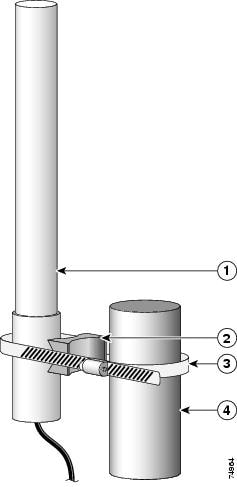
|
1 |
Antenna |
2 |
Mounting bracket |
|
3 |
Hose clamp |
4 |
Mast |
Figure 2 Antenna Drain Details
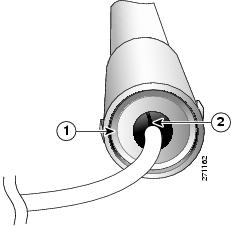
|
1 |
Drain ring |
2 |
Antenna cable |
Step 2  Align the antenna so that the metal base is even with or above the top of the mast tubing.
Align the antenna so that the metal base is even with or above the top of the mast tubing.
Step 3  Tighten the hose clamp until the antenna is secure on the mast.
Tighten the hose clamp until the antenna is secure on the mast.
Step 4  Connect the antenna coaxial cable to the lead-in cable.
Connect the antenna coaxial cable to the lead-in cable.
Step 5  Remove the yellow mounting instruction label.
Remove the yellow mounting instruction label.
Step 6  If the installation is outdoors, weatherproof the antenna connection (the point at which the antenna cable connects to another cable or device).
If the installation is outdoors, weatherproof the antenna connection (the point at which the antenna cable connects to another cable or device).







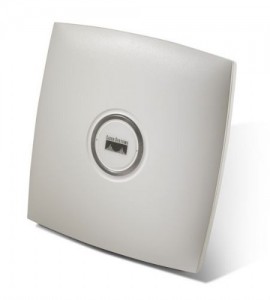

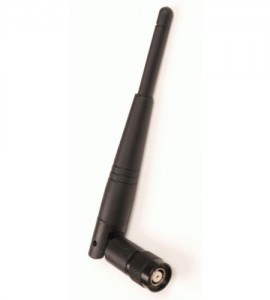
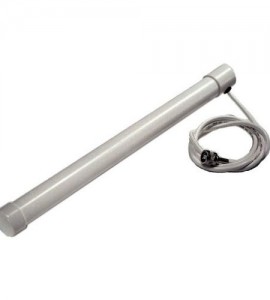

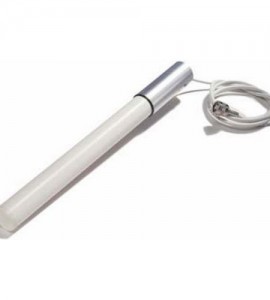

Cisco ANT2506 Broşür